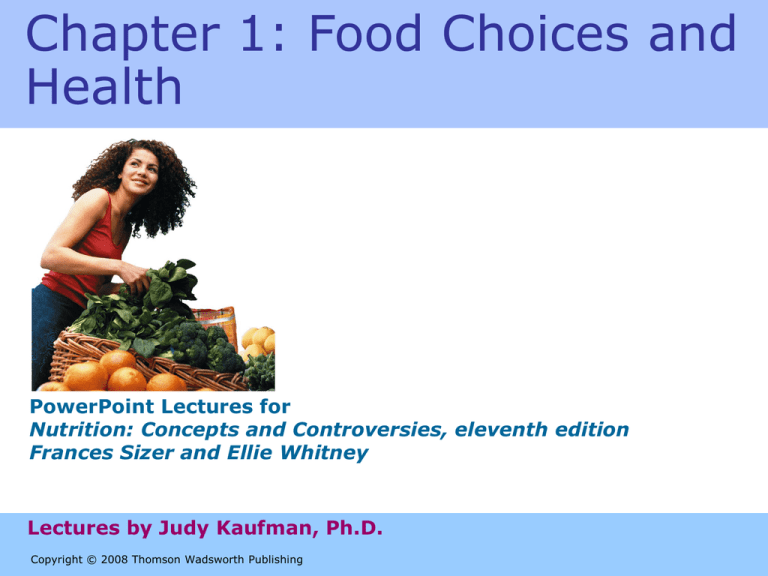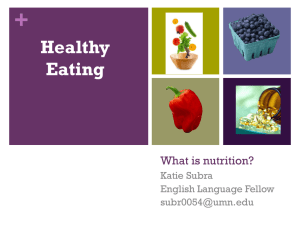Chapter 1: Food Choices and Human Health
advertisement

Chapter 1: Food Choices and Health PowerPoint Lectures for Nutrition: Concepts and Controversies, eleventh edition Frances Sizer and Ellie Whitney Lectures by Judy Kaufman, Ph.D. Copyright © 2008 Thomson Wadsworth Publishing What is this chapter about?? Why should we care about nutrition? What are the nutrients in foods and what roles do they play in the body? What constitutes or forms a nutritious diet? How do people go about making changes to their diets? Nutrition is... the science of how food nourishes the body. Food is... any substance that the body can take in and absorb that will enable it to stay alive and grow supplies energy and nutrients diet is... Foods and beverages a person usually eats and drinks? nutrients are... Parts of food that are important for the body to function. Provide: energy, serve as building material, help maintain or repair body parts, and support growth. Nutrients include 1. water 2. carbohydrates 3. fats 4. proteins 5. vitamins 6. minerals Question????? According to the definition of food what are some typical and aytipical examples of food? A Lifetime of Nourishment The nutrients in food support growth, maintenance, and repair of the body. Deficiencies, excesses, and imbalances of nutrients bring on the diseases of malnutrition. When you choose foods with nutrition in mind, you can enhance your own well being The Diet and Health Connection pg. 3 Nutrition profoundly affects health. Chronic diseases have a connection to a poor diet. Which of these diseases are chronic? The Diet and Health Connection Chronic diseases include: – Heart disease – Diabetes – Some cancers – Dental disease – Adult bone loss The Diet Dietand andHealth Health Connection The Connection Chronic diseases – Cannot be prevented by a good diet alone – To some extent determined by genetics, activities, and lifestyle Genetics and Individuality Inherited disease - condition that is passed from a parent to a child – Hemophilia, sickle cell anemia, Down syndrome, cystic fibrosis, and many others Acquired disease - condition that is associated with infections, lifestyle behaviors or diet – Heart attack, diabetes, stroke, mineral or vitamin deficiencies Genetics and Individuality pg. 3 Choice of diet influences long-term health within the range set by genetic inheritance. Nutrition has little influence on some diseases but strongly affects others. The Importance of Nutritional Genomics Integration of nutrition, genomic science, and molecular biology. – Looks at how nutrients affect the activities of genes and how genes affect the activities of nutrients. – Expected to advance treatment of certain diseases. Other Lifestyle Choices 0 Only two common lifestyle habits have a stronger influence on long-term health than dietary choices. Can you guess which? – Smoking & other tobacco use – Excessive alcohol consumption Other Lifestyle Choices Tobacco use and alcohol and other substances can destroy health. Staying active, getting enough sleep, and stress can all affect health. Healthy People 2010: Nutrition Objectives for the Nation pg. 5 U.S. Department of Health and Human Services sets nutrition objectives for the nation each decade The Human Body and Its Food Nutrients – parts of food needed for the body’s functioning. – Roles: • Provide energy • Building material • Maintenance and repair • Support growth 0 The Human Body and Its Food Where does energy come from? Body uses energy when doing work Energy comes directly from the sun by way of plants When you eat plants you are getting the stored energy from the sun. When you eat animal tissue you are eating compounds containing energy that came originally from the sun The Human Body and Its Food Food and the human body are made up of the same materials Meet the Nutrients 0 Essential nutrients – must be obtained in the diet because the body does not make them Found in all 6 classes Glucose Linoleic acid linolenic acid 9 amino acids of 20 All 13 25 Yes Meet the Nutrients Calorie - the amount of heat energy needed to raise the temperature of one kilogram (1 liter) of water by 1oC – Explode food pieces in a special water-lined chamber and measure the heat given off from the explosion Meet the Nutrients Gram – a unit of weight. – For instance, one teaspoon of sugar weighs roughly 5 grams. Meet the Nutrients Can I Live On Just Supplements? Elemental diets – diets with a precise chemical composition. – Lifesaving for people who cannot eat ordinary food. – Not appropriate over long periods for healthy people as “meal replacers” or “insurance” against malnutrition. Can I Live On Just Supplements? Food is better than supplements – The digestive system can break down and absorb nutrients most efficiently from whole foods – Eating provides physical, psychological, and social comfort for people as well When you eat foods, you are receiving more than nutrients Can I Live On Just Supplements? Some foods offer beneficial nonnutrients called phyto-chemicals. Confer taste, color, and possible health benefits. Some foods offer beneficial nonnutrients Nonnutrient- compunds other than the 6 nutrients that are present in foods and that have biological activity in the body. Phytochemicals- nonnutrient compunds in plants that have bilogical activity in the body. The Challenge of Choosing Foods Foods come in a bewildering variety in the marketplace, but the foods that form the basis of a nutritious diet are basic foods. The Abundance of Foods to Choose From 0 The Abundance of Foods to Choose From All foods once looked like this... The Challenge of Choosing Foods ...but now many foods look like this. How, Exactly, Can I Recognize a Nutritious Diet? All of these factors help to build a nutritious diet. Elements of a Healthy Diet - ABCMV Adequacy - get enough of essential nutrients. Balance - contains a good proportion of nutrients. No overemphasis of a food group. Calorie control - choose foods to maintain ideal body weight. Moderation - eat any food in reasonable-size portions. Variety - eat different types of food to prevent boredom. Why People Choose Foods Eating is an intentional act. People choose: – What to eat – Where to eat – Who to eat with – How to prepare it Cultural and Social Meanings Attached to Foods Food ways – the sum of a culture’s habits, customs, beliefs, and preferences concerning food. Sharing ethnic food is a way of sharing culture Cultural and Social Meanings Attached to Foods 0 Omnivore – A person who eats food of both plant and animal origin, including animal flesh Vegetarian – Lacto-ovo – animal products but no flesh – Vegan – neither animal products nor flesh Where do you fit in? 1. I eat everything. 2. I don’t eat red meat but I eat poultry/fish. 3. I am a lacto-ovo vegetarian 4. I am a vegan. 5. I eat fish but no other animal. Factors That Drive Food Choices Advertising Positive associations Availability Region of the country Economy Social pressure Emotional comfort Values or beliefs Habit Weight Personal preference Nutritional value THE SCIENCE OF NUTRITION Nutrition is a science so scientists and dieticians work together to develop studies that are well designed, controlled, and reviewed by other experts Many studies take a long time to complete so information may not be available as quickly as most people would like it to be The Scientific Approach 0 The Scientific Approach: Research Designs – 4 types Examples of research design Epidemiological study This country’s food supply has more olive oil and they have less heart disease. Lab study Let’s prove that a vitamin C deficiency leads to scurvy in these rats. The Scientific Approach: Research Designs – 4 types Case study: This person eats too little iodine and has goiter Intervention study: Let’s add foods with vitamin C to his diet and see if he gets fewer colds. Scientific Challenge Once a finding is published, it is still only preliminary One experiment does not “prove” or “disprove” anything Must be duplicated, supported, and challenged by other scientists A finding that has stood up to repeated rigorous testing may become a theory Can I Trust the Media to Deliver Nutrition News? Read nutrition information with an educated eye Consider the source of the information – Is it from a reputable journal? A magazine? An Internet chat room? A talk show? Your mother??? National Nutrition Research There are two ongoing national scientific research projects: 1. National Health and Nutrition Examination Surveys (NHANES) • Asks about 50,000 people what they have eaten • Records measures of their health status National Nutrition Research 1. Continuing Survey of Food Intakes by Individuals (CSFII) - Records what people have actually eaten for two days - Compares the foods they have chosen with the recommended food selections Consumer Corner: Reading Nutrition News with an Educated Eye Refereed journals: Review journals examine all available evidence on major topics; research journals report details of the methods, results and conclusions of recently completed experiments. Making Diet Changes Nutrition knowledge is useful if it helps people improve their diets. People need to change behaviors. Taking inventory and setting goals Track food intake over several days and compare to standards Set small, achievable goals in areas that need changing The Process of Change Psychologists describe 6 stages of behavior change Obstacles to Change Obstacles can cause lapses Lapses can arise in these general areas: – Competence – Confidence – Motivation The Concept of Rewards Motivation is based on rewards Rewards are affected by: – Value – Timing – Costs – Probability Start Now As you read this book, little reminders entitled Start Now appear at the end of each chapter. They invite you to go to the ThomsonNOW Internet website to take inventory of your current behaviors and set goals for needed changes. Summary: Behavior Change Behavior change follows a predictable pattern. Motivation is the force that moves people to act. It is affected by the weights people give to the rewards and the consequences that will follow the action. Food Feature How can I get enough nutrients without consuming too many calories? – Nutrient Density – a measure of nutrients per calorie. Food Feature 0 Food Feature Which food is the most nutrient dense? a. Oreo cookie b. Chicken soup c. Milk shake d. Skim milk Answer: d Controversy: Sorting the Impostors from the Real Nutrition Experts Who speaks on nutrition? Controversy: Sorting the Impostors from the Real Nutrition Experts Controversy: Sorting the Impostors from the Real Nutrition Experts Identifying Valid Nutrition Information Nutrition on the Net Nutrition on the Net PUBMED (www.pubmed.org) Internet resource Who Are the True Nutrition Experts? Who Are the True Nutrition Experts? Detecting Fake Credentials Detecting Fake Credentials Sassafras and Charlie display their professional credentials




